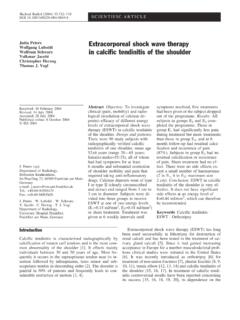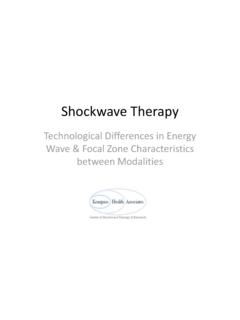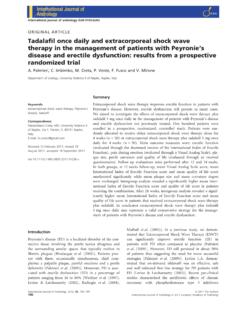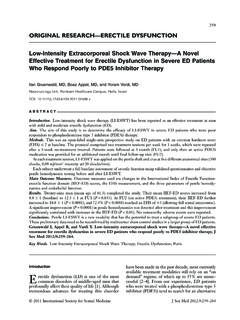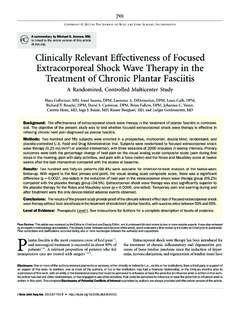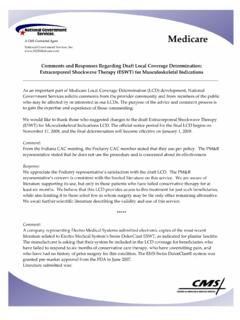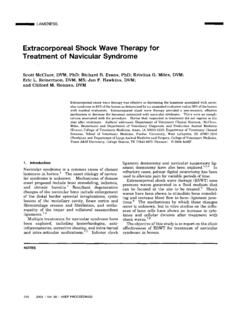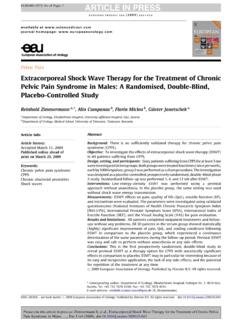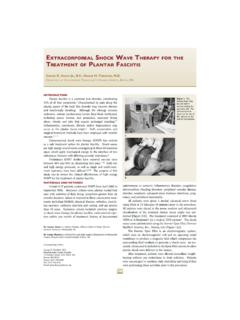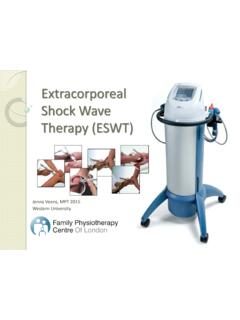Transcription of Extracorporeal Shock Wave Therapy: Current Evidence
1 SUPPLEMENTARTICLEE xtracorporeal Shock Wave therapy : Current EvidenceBoris A. Zelle, MD,* Hans Gollwitzer, MD, Michael Zlowodzki, MD, and Volker Bu hren, MD Objectives:The aim of this article is to provide a concise review ofthe basic science of Extracorporeal Shock wave therapy (ESWT) andto perform a systematic review of the literature for the use of ESWTin the treatment of fractures and delayed Sources:Articles in the English or German language wereidentified for the systematic review by searching PubMed-MEDLINE from 1966 until 2008, Cochrane Database of Systematic Reviews,Cochrane Database of Abstracts of Reviews of Effects, CochraneCentral Register of Controlled Trials, and relevant meeting abstractsfrom 2007 to 2008.
2 Moreover, the bibliographies of the identifiedarticles were Selection:We included clinical outcome studies of ESWT inthe treatment of fractures and delayed unions/nonunions. Reportswith less than 10 patients were excluded. Nonunions after correctiveosteotomies or arthrodeses were Extraction:Sample size, level of Evidence , definition ofdelayed union, definition of nonunion, time from injury to shockwave treatment, location of fracture, union rate, and complicationswere extracted from the identified Synthesis:Data of 924 patients undergoing ESWT fordelayed union/nonunion were extracted from 10 studies. All articleswere graded as level 4 studies.
3 The overall union rate was 76% (95%confidence interval 73% 79%). The union rate was significantlyhigher in hypertrophic nonunions than in atrophic :Data from level 4 studies suggest that Shock wavetherapy seems to stimulate the healing process in delayed unions/nonunions. However, further investigations are required.(J Orthop Trauma2010;24:S66 S70)INTRODUCTIONA dvances in the operative treatment of long-bone fracturescontinue to improve patient outcomes. About 5% 10% of million fractures that occur annually in the United Statesare complicated by delayed union or surgicaltreatment of delayed unions/nonunions remains challengingand usually requires bone grafting and revision open reductionand internal fixation.
4 With modern state-of-the-artsurgical techniques, the majority of nonunions can be 5 However, the surgical treatment is usuallyassociated with additional hospital days, comorbidity fromthe surgical procedure, and significant socioeconomic an effort to decrease patient morbidity and health care costs,the use of noninvasive methods, such as the extracorporealshock wave therapy (ESWT), seems to be a valuablealternative in the treatment of delayed unions and has been suggested for the treatment of variousmusculoskeletal disorders such as plantar fasciitis, lateralepicondylitis, calcifying tendinitis, and avascular necrosis ofthe femoral 13 Moreover, ESWT has also been sug-gested as a stimulator of bone healing, and it has beenemployed in the treatment of delayed pathway by which ESWT may exert its effect on bonehealing remains the subject of ongoing experimental inves-tigations.
5 The aim of this article is to provide a concise reviewof the basic science of ESWT on fracture healing and tosystematically review the Current Evidence in the literature forthe use of ESWT in the treatment of fractures and SCIENCE OF ESWTS hock waves are single high-amplitude sound wavesgenerated by electrohydraulic, electromagnetic, or piezoelec-tric methods that propagate in tissue with a sudden rise fromambient pressure to its maximum pressure at the wave front,followed by lower tensile to theInternational Society for Medical Shockwave Treatment(ISMST) ( ; accessed December 22, 2008),a Shock wave is defined as a sonic pulse characterized bya high peak pressure (500 bar), a short life cycle (10 ms),fast pressure rise (,10 ns), and a broad frequency spectrum(16 20 MHz).
6 The Shock waves are focused to a zone ofhighest energy in front of the applicator and therefore reachhighest energy concentration in the focus zone within thetreated tissue. The most important mechanical effects of shockwaves are reflection with pressure and tension forces at bordersof different impedances and the generation of cavitationbubbles in liquids. These vacuum bubbles typically collapseAccepted for publication November 13, the *Department of Orthopaedic Surgery, University of PittsburghSchool of Medicine, Pittsburgh, PA; Department of Orthopaedic andTrauma Surgery, Technische Universita t Mu nchen, Munich, Germany; Department of Orthopaedic Surgery, University of Minnesota, Minne-apolis, MN; and Department of Trauma Surgery, Berufsgenossenschaft-liche Unfallklinik Murnau, Murnau, funding was received for the preparation of this : Boris A.
7 Zelle, MD, Department of Orthopaedic Surgery, Universityof Pittsburgh School of Medicine, Kaufmann Building, Suite 1011, 3471 Fifth Avenue, Pittsburgh, PA 15213 (e-mail: 2010 by Lippincott Williams & WilkinsS66| Orthop Trauma Volume 24, Number 3 Supplement, March 2010asymmetrically and induce local shear forces by high velocityliquid streams (so-called jet streams ).15 17 Several authors have investigated the biologic effects ofESWT on the molecular 30 Two major mechanismsseem to be involved in the translation of mechanical shockwave energy into its biological effects. These include mem-brane hyperpolarization and the formation of free et al and Chen et al demonstrated Shock waves to inducehyperpolarization of cell membranes, followed by Ras activa-tion and a local increase of stimulating factors like trans-forming growth factorb1, vascular endothelial growth factor(VEGF) A (VEGF-A))
8 , and mitogen-activated ,25 27,30 Furthermore, Shock waves have been shownto produce oxygen radicals, which are supposed to play a keyrole in translating the mechanical energies of the Shock wavesinto biological et al demonstrated that oxygenradical production induced a cascade of kinases and growthfactors, such as VEGF, transforming growth factorb1, BMP-1,BMP-2, and BMP-7, which was followed by an increasedgrowth and differentiation of mesenchymal cells towardosteoprogenitor 30 The effect of ESWT on fracture healing in vivo has beeninvestigated in numerous studies using different animalmodels. Although some investigators did not observe anypositive effects of ESWT on bone healing in their in vivomodels,31 33numerous authors reported a stimulating effectof ESWT on bone formation in vivo using different ,24,34 37In vivo studies in rabbits demonstrated thatexposure of normal bone to ESWT may result in increasednew bone investigations using fracturemodels in rats, rabbits, and dogs showed increased callusformation, decreased healing time, and increased mechanicalstrength of broken bones with exposure to ,24,35In themost recent study using a fracture model in rabbits.
9 Wanget al37observed a significantly better bone strength, morecortical bone formation, a higher number of neovessels, andincreased angiogenic and osteogenic growth markers includ-ing VEGF, endothelial nitric oxide synthase, proliferating cellnuclear antigen, and BMP-2 in animals undergoing ESWT treatment as compared with the control group. Johannes et al36investigated the effect of ESWT using a nonunion model ina dog. These authors reported that ESWT exposure resulted inincreased healing rates in established nonunions as comparedwith a control dose-dependent effect of the ESWT has been thesubject of several investigations. Dose-dependentstimulation ofbone cells in vitro was observed by Kusnierczak et al38aftershock wave application, with a minimum threshold energynecessary to effect bone cell growth.
10 Bone cell stimulationseemed to depend on the total amount of energy applied, ratherthan on single physical parameters like energy flux density ornumber of administered impulses. Furthermore, these authorsreported decreased cell survival with excessive energy fluxdensities. These findings from in vitro studies were confirmedin subsequent in vivo studies demonstrating a dose-dependenteffect of ESWT on bone mass and bone strength in acutefracture models in rabbits and in bone defect models ,21,24In addition, Maier et al39,40provided further in vivodata on the deleterious effects of very high energy fluxdensities, which were associated with soft tissue edema,cortical fractures, periosteal detachment, intraosseous bleed-ing.
